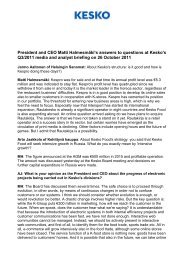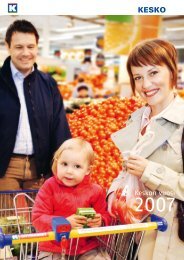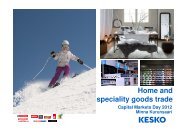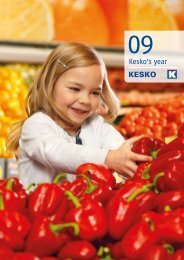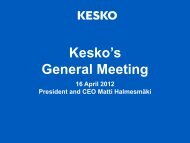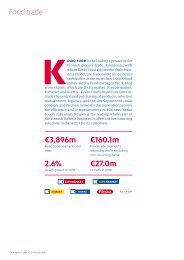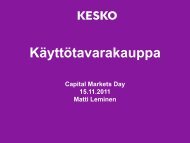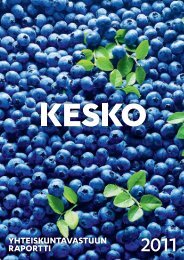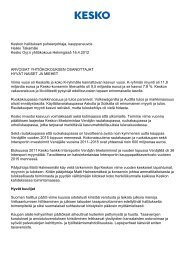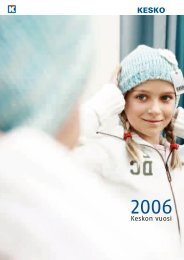Pdf version (3.2 MB) - Kesko
Pdf version (3.2 MB) - Kesko
Pdf version (3.2 MB) - Kesko
You also want an ePaper? Increase the reach of your titles
YUMPU automatically turns print PDFs into web optimized ePapers that Google loves.
ENvIRONMENTal<br />
REsPONsIBILITy<br />
CO 2 e EMIssIONs<br />
Management approach to environmental responsibility including<br />
operating principles and monitoring and control systems are<br />
described on pages 50–57.<br />
At the end of 2011, environmental systems covered 63% of the<br />
<strong>Kesko</strong> companies' net sales in Finland and 53% of the whole Group’s<br />
net sales. The coverage has been calculated in proportion to retail<br />
sales. So far, environmental systems have not been adopted in the<br />
operations outside Finland.<br />
The K-Group's environmental policy, updated in 2011, can be read<br />
at www.kesko.fi/responsibility.<br />
MATERIALS<br />
Company cars,<br />
Finland<br />
2,949 t<br />
Transportation,<br />
Finland<br />
46,350 t<br />
MATERIALS USED, EN1<br />
In respect of <strong>Kesko</strong>, materials used refer to the quantities of packaging<br />
materials of products imported or packaged by <strong>Kesko</strong>. <strong>Kesko</strong><br />
reports these materials to the authorities in compliance with the EU<br />
packaging directive. <strong>Kesko</strong>’s logistics operations take account of the<br />
possibilities to use more environmentally friendly materials in its<br />
operations and packaging systems.<br />
<strong>Kesko</strong> guides its customers in comparing the environmental properties<br />
of products and packaging, their proper use and disposal<br />
after use. <strong>Kesko</strong> can have an impact on the packaging materials<br />
and quantities, especially when developing its own brand products.<br />
Among the clearly most important properties of packaging is to sufficiently<br />
protect the product from spoilage before use and to enable<br />
the whole product quantity to be used. According to surveys (Source:<br />
MTT Agrifood Research Finland FutupackEKO), the environmental<br />
impacts of foodstuffs packaging as a rule are significantly smaller<br />
than the emissions from the production and consumption of the<br />
foodstuff itself.<br />
Read about the objectives and progress of <strong>Kesko</strong>’s recycling and<br />
material efficiency on pages 58–59.<br />
quantities of packaging imported and packaged by <strong>Kesko</strong>, tons<br />
2011 2010 2009<br />
Anttila/K-citymarket 2,231 2,575 1,146<br />
Rautakesko 2,966 3,701 2,978<br />
<strong>Kesko</strong> Food 17,869 18,101 25,628<br />
In 2009, K-citymarket was included in <strong>Kesko</strong> Food's figures.<br />
Excluding wood packaging and roll containers.<br />
MATERIALS USED THAT ARE RECyCLED INPUT<br />
MATERIALS, EN2<br />
In 2011, 277 tons of packaging plastic recovered from <strong>Kesko</strong> Food's<br />
goods transportation was recycled. Because most part of the reported<br />
packaging materials go to consumers, the calculation of the proportion<br />
of recycled materials is not appropriate. Read more at EN27.<br />
ENERGy<br />
Air travel,<br />
Finland<br />
2,101 t<br />
Energy consumption in<br />
properties<br />
141,083 t<br />
DIRECT ENERGy CONSUMPTION, EN3, AND INDIRECT<br />
ENERGy CONSUMPTION, EN4<br />
In 2011, <strong>Kesko</strong>’s office and warehouse properties and the K-Group<br />
stores in Finland consumed a total of 1,071 GWh of electric and heat<br />
energy. In the other operating countries, the total consumption of<br />
heat and electricity was 129.1 GWh in 2011.<br />
<strong>Kesko</strong> Corporate Responsibility Report 2011 71




